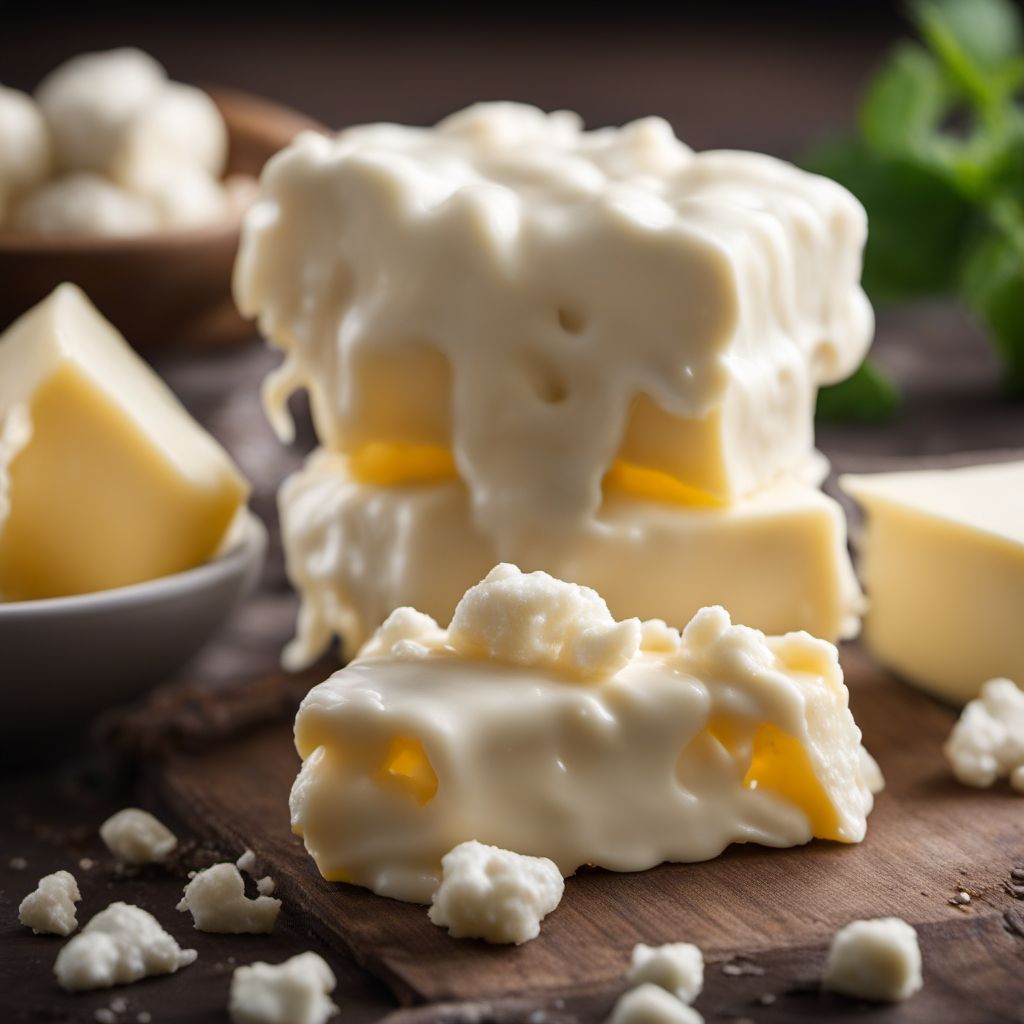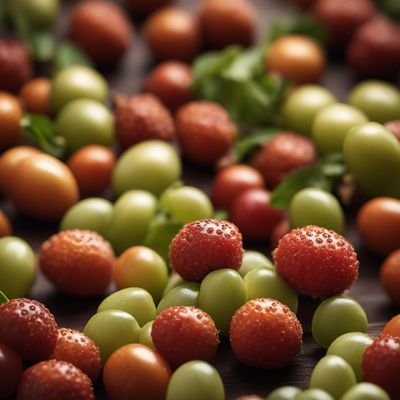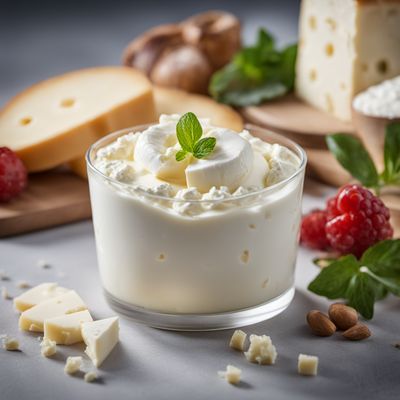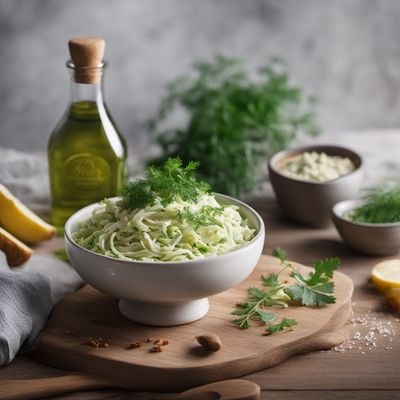
Ingredient
Cheese curd
Squeaky Cheese Delight
Cheese curd is the solid form of curdled milk that is obtained during the cheese-making process. It has a mild and slightly tangy flavor, with a springy and squeaky texture. Cheese curds are commonly enjoyed on their own as a snack, but they can also be used in various dishes such as poutine, salads, sandwiches, and casseroles, adding a delightful cheesy element.
Origins and history
Cheese curd has a long history and is believed to have originated in the Middle East thousands of years ago. It was later introduced to Europe, where it became a staple in many regional cuisines. Today, cheese curds are popular in countries like Canada and the United States, particularly in the Midwest and Quebec, where they are commonly used in dishes like poutine. The curds are typically made from cow's milk, but variations using goat's or sheep's milk can also be found.
Nutritional information
Cheese curd is a good source of protein and calcium, essential for maintaining healthy bones and teeth. It also provides vitamins A and B12. However, it is important to note that cheese curds are high in saturated fat and sodium, so they should be consumed in moderation as part of a balanced diet.
Allergens
Cheese curd may contain allergens such as milk, depending on the specific type of cheese used. Individuals with lactose intolerance or milk allergies should exercise caution and check the ingredient list before consuming cheese curds.
How to select
When selecting cheese curds, look for fresh curds that are moist, with a slightly elastic texture. They should have a mild aroma and a clean, milky flavor. Avoid curds that are dry, crumbly, or have a strong odor. If possible, purchase cheese curds from local cheese producers or specialty shops for the best quality and flavor.
Storage recommendations
To maintain the freshness and squeaky texture of cheese curds, store them in the refrigerator at a temperature between 34°F (1°C) and 38°F (3°C). It is best to keep them in their original packaging or in a breathable container to prevent moisture buildup. Cheese curds are best consumed within a few days of purchase for optimal flavor and texture.
How to produce
Cheese curds are typically produced by curdling milk with the addition of rennet or an acid, such as lemon juice or vinegar. The curdled milk is then cut into small pieces, heated, and drained to separate the whey. The resulting curds are then pressed and shaped into blocks or bite-sized pieces. While cheese curds can be made at home, the process requires specific equipment and expertise, so it is often more convenient to purchase them from cheese producers or local markets.
Preparation tips
Cheese curds can be enjoyed as a snack on their own, providing a satisfying and cheesy bite. They are also commonly used in dishes like poutine, where they are topped with gravy and melted cheese. Cheese curds can be melted in sandwiches, added to salads for a burst of flavor, or incorporated into casseroles for a cheesy twist. When using cheese curds in recipes, they can be cut into smaller pieces or shredded depending on the desired texture.
Culinary uses
Cheese curds are commonly used in Canadian cuisine, particularly in the iconic dish poutine, where they are served with french fries and gravy. They are also popular in the Midwest region of the United States, where they are enjoyed as a snack or used in various dishes. Additionally, cheese curds can be found in other countries with a strong cheese-making tradition.
Availability
Cheese curds are commonly available in Canada, the United States, and other countries with a thriving dairy industry. They can be found in grocery stores, specialty cheese shops, and farmers markets.
More ingredients from this category » Browse all

Cheese, triple creme
Decadent Delights: Exploring Triple Creme Cheese

Cheese, urda
The Creamy Delight: Exploring the World of Urda Cheese

Cheese, crescenza
Creamy Delight: Unveiling the Allure of Crescenza Cheese

Cheese, chevre frais
Fresh and Tangy Goat's Cheese

Ricotta
Velvety Italian Curds

Clotted cream
The Creamy Indulgence

Cream cheese
Velvety Delight: Exploring the World of Cream Cheese

Cheese, mizithra
The Versatile Delight

Cottage cheese
Creamy Curds: Exploring the Delights of Cottage Cheese

Quark
Creamy Delight: Unveiling the Versatility of Quark

Skyr
The Icelandic Superfood

Cheese, boilie
Savory Delight: Boilie Cheese
Recipes using Cheese curd » Browse all

Slow-Cooked Spanish Pork Cheeks with Red Wine Sauce
Tender Delights: Spanish Pork Cheeks in a Rich Red Wine Sauce

Quebecois Bolillo Sandwich
Maple-Glazed Bolillo Delight

Navyath Muslim Spiced Fish Stew
Savor the Aromas of Navyath Muslim Spiced Fish Stew

Mordovian Cholera
Savory Mordovian Pie: A Fusion of Swiss and Mordovian Flavors

Swedish-style Fish Stew
Nordic Sea Delight: Swedish-style Fish Stew

Canarian Seafood Stew
Oceanic Delight: Canarian Seafood Stew

Silesian-style Fish Fillet with Remoulade
Crispy Fish Delight with Silesian Remoulade

Wisconsin-style Cheese Curd Vada Pav
Cheesy Curd Delight: Wisconsin-style Vada Pav

Jinbole Chowder
New England Twist: Jinbole Chowder - A Hearty Delight from South Sudan

Viennese-style Fish Stew
Danube Delight: Viennese-style Fish Stew

Creamy Fish Soup
Silesian-style Creamy Fish Soup: A Delightful Fusion of Flavors

Omelette Arnold Bennett
Savory Smoked Haddock Omelette